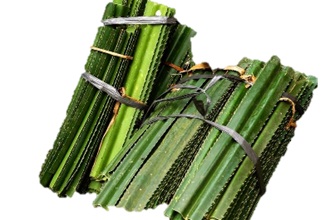Preparation and Characterization of Cellulose Acetate from Pandanus tectorius via Microwave Irradiation
Abstract
This research focuses on extracting cellulose from thorn pandan and evaluating its potential as a raw material for cellulose acetate. Thorn pandan contains polysaccharides, especially cellulose. In its fabrication process, cellulose acetate is produced from cellulose acetylation reaction. Cellulose is extracted using the Microwave-assisted Extraction method with variations in NaOH concentration (1, 2, and 3%), H2O2 concentration (10, 20, and 30%), and time variables (20, 40, and 60 minutes). Extraction optimization was performed with Response Surface Methodology (RSM) model BBD (Box-Behken Design). Several characterizations were carried out to determine the characteristics of cellulose acetate, namely Degree of Acetylation, FT-IR spectroscopy and X-Ray Diffraction (XRD). The highest cellulose yield obtained in the extraction process was 50.7% with a variable of 3% NaOH, 30% H2O2 and 60 minutes. XRD analysis shows the angle value 2θ = 22.53798° of thorn pandan cellulose structure is almost similar to commercial cellulose. FTIR functional group identification of cellulose acetate showed the presence of carbonyl (C=O) and (C-O Acetyl) group, respectively seen at wave numbers 1734 cm-1 and 1256 cm-1. The acetyl content of cellulose acetate from thorn pandan produced is 35.475%. Therefore, thorn pandan biomass has the potential as a raw material for making cellulose acetate.
Downloads

Copyright (c) 2024 Meta Fitri Rizkiana, Abdul Malik Karim Amrullah, Nor Elisah, Helda Wika Amini, Bekti Palupi, Istiqomah Rahmawati, Boy Arief Fachri

This work is licensed under a Creative Commons Attribution-NonCommercial-NoDerivatives 4.0 International License.
Authors who publish with this journal agree to the following terms:
- Copyright on any article is retained by the author(s).
- The author grants the journal, the right of first publication with the work simultaneously licensed under a Creative Commons Attribution License that allows others to share the work with an acknowledgment of the work’s authorship and initial publication in this journal.
- Authors are able to enter into separate, additional contractual arrangements for the non-exclusive distribution of the journal’s published version of the work (e.g., post it to an institutional repository or publish it in a book), with an acknowledgment of its initial publication in this journal.
- Authors are permitted and encouraged to post their work online (e.g., in institutional repositories or on their website) prior to and during the submission process, as it can lead to productive exchanges, as well as earlier and greater citation of published work.
- The article and any associated published material is distributed under the Creative Commons Attribution-NonCommercial-NoDerivatives 4.0 International License.





_copy1.png)










